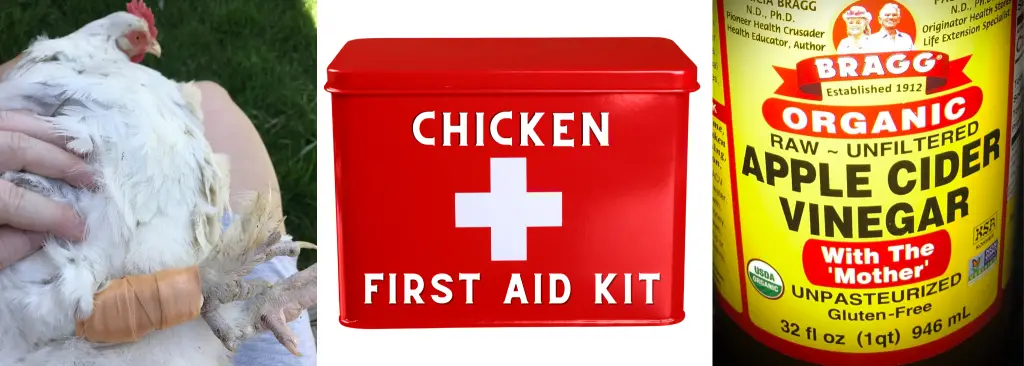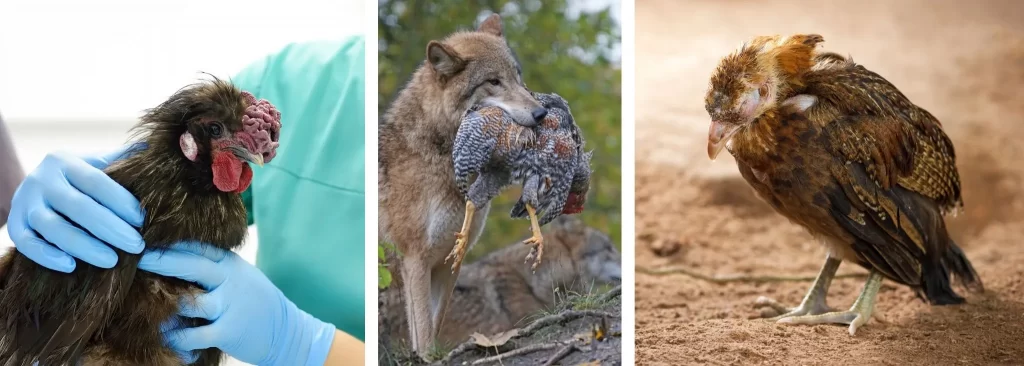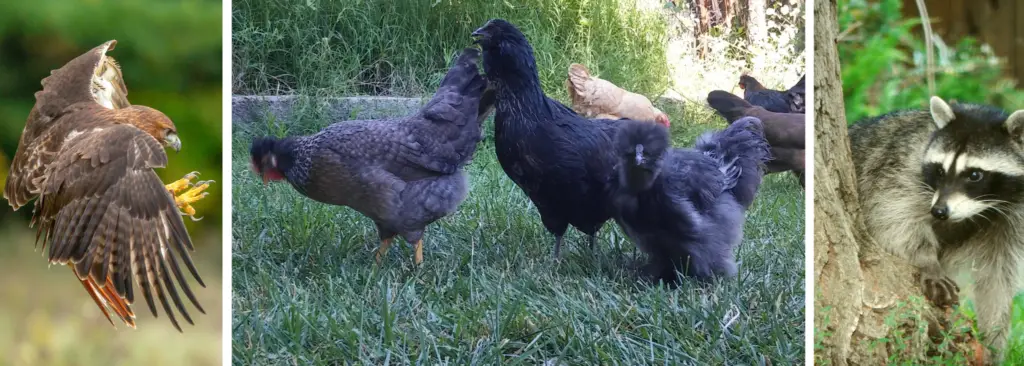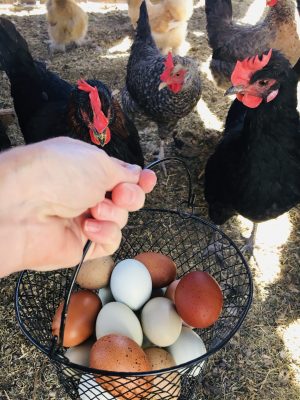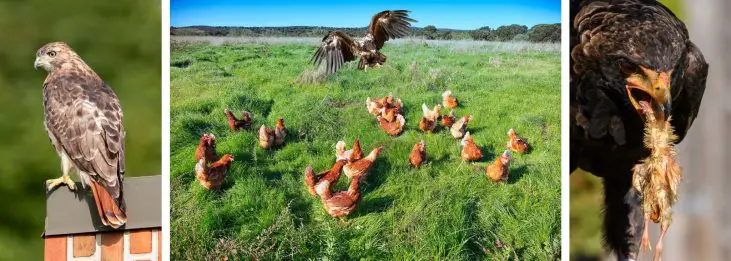
If you own chickens, no matter where you live, there is always some sort of predator that you need to protect your chickens from. Your hens rely on you to help keep them protected.
This article will help you to identify if a hawk attacked your chickens and inform you as to what you can do to protect your chickens from a future attack.
Hawks are one of the most common chicken predators. They are more common in rural areas, but are also seen in the backyards of city folks. One of the most important things that a chicken keeper needs to do for their flock is to keep them safe from arial predators such as hawks.
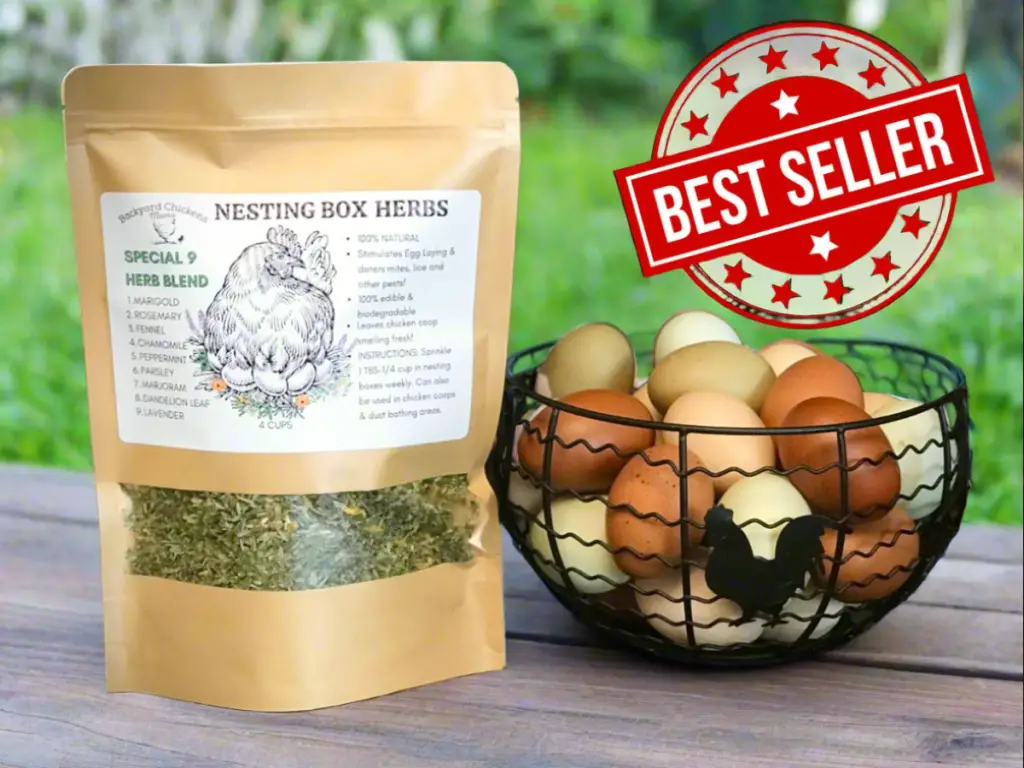
Increases egg laying naturally.
- Improves chicken health.
- Deters parasites: mites, lice, fleas & flies as well as mice, rats, raccoons, coyotes, opossums and more!
- On SALE!
- Shop: Nesting Box Herbs
“How do I know if a hawk attacked my chickens?” Signs of hawk attacks on backyard chickens:
- What Does it Look Like if a Hawk Attacks a Chicken? (Identifying Signs of Hawk Attacks on Chickens)
- How Does a Hawk Kill a Chicken: Full Size, Bantam and Baby Chicks
- How Does a Hawk Kill a Chicken?
- Could a Hawk Fly Away With a Chicken?
- Can a Hawk Kill a Full Grown Chicken?
- What Time of Day Do Hawks Usually Hunt?
- What Do Hawks Eat?
- What Can I Do if a Hawk is Killing My Chickens? (Chicken Protection from Hawks)
- Chicken Protection from Hawks-9 Best Ways
- Can You Shoot a Hawk if it is Attacking Your Chickens?
- What are Hawks Afraid of?
- Will a Fake Owl Keep Hawks Away from Chickens?
- Will a Hawk Attack a Human?
- Chicken Predators Chart
- List of Largest Hawks
- Conclusion: How do I know if a Hawk Attacked My Chickens?
What Does it Look Like if a Hawk Attacks a Chicken? (Identifying Signs of Hawk Attacks on Chickens)
Depending upon the size of the chicken, a hawk attacking a chicken will look very different. Full size adult chickens cannot be carried away, many bantams can be, but a young chick under 3 lbs can be easily swooped up and consumed in a different location.
Below are the differences in each of these attacks.
How Does a Hawk Kill a Chicken: Full Size, Bantam and Baby Chicks
Full Size Adult Chicken Attack
One hawk cannot eat an entire chicken in one sitting. A 3 lb. Redtail Hawk cannot fly away with a 6 lb. chicken.
How do hawks kill chickens?(Full Grown) If you catch it shortly after the kill, you may see the neck dislocated from the chicken and just the head and neck(crop) area eaten.
Chances are the hawk is sitting up in a tree, waiting until it is ready to eat again. It is also keeping an eye on its kill to protect it from other predators.
If you don’t catch the kill right away, the hawk will keep returning until it has eaten enough of the chicken that it can carry it off to a more secure location to eat the rest. At this point, you may only see a halo of feathers on your property.
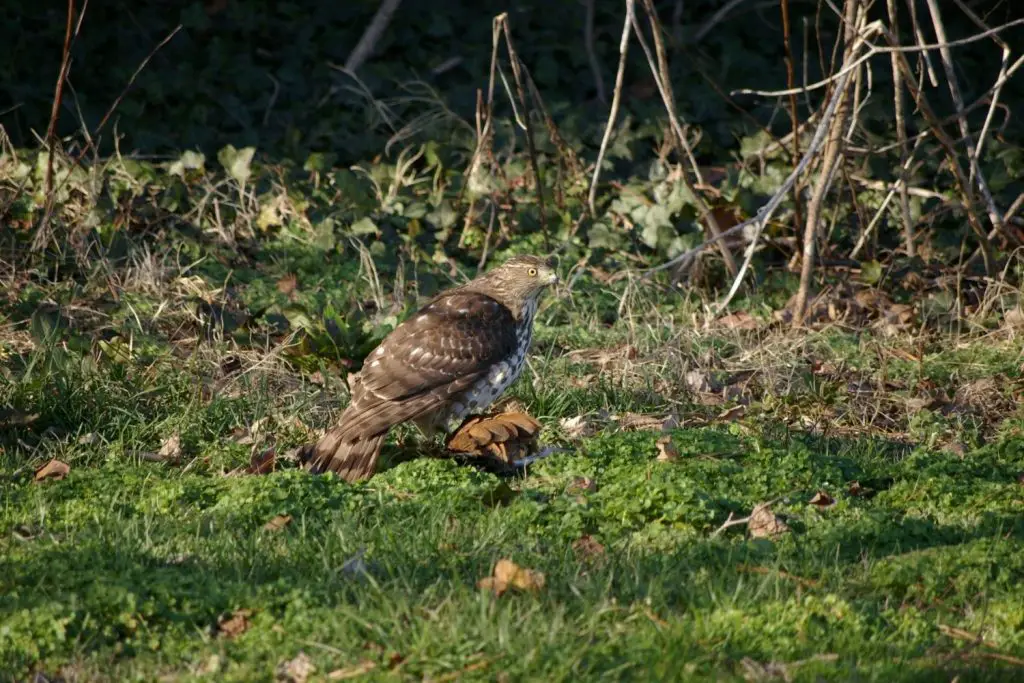
Bantam Chicken Attack
How do hawks kill chickens?(bantams) Many bantam chickens, under 3 lbs., can easily be snatched up by a hawk. You may not see any evidence of an attack, just missing chickens.
PRO TIP: If you have experienced a hawk attack, be prepared for another attack. Once a hawk has attacked and killed, it will frequently return for more.
Baby Chick Attack
How do hawks kill chickens?(baby chicks) Hawks will choose to grab a baby chick or smaller chicken over a full size chicken. They instinctively know that they can easily swoop down and fly off with them.
Hawks prefer to take their prey to a safe location to eat it if they can and baby chicks are perfect for this.
Most baby chicks will not put up a fight and are light enough for most varieties of hawks to fly away with.
Chicks are easily snatched up whole with a hawks sharp talons. The only thing you may notice missing chicks.
Young chicks should never be left out to free range without supervision. Consider getting hawk netting to place above their enclosure to prevent arial predators from attacking.
How Does a Hawk Kill a Chicken?
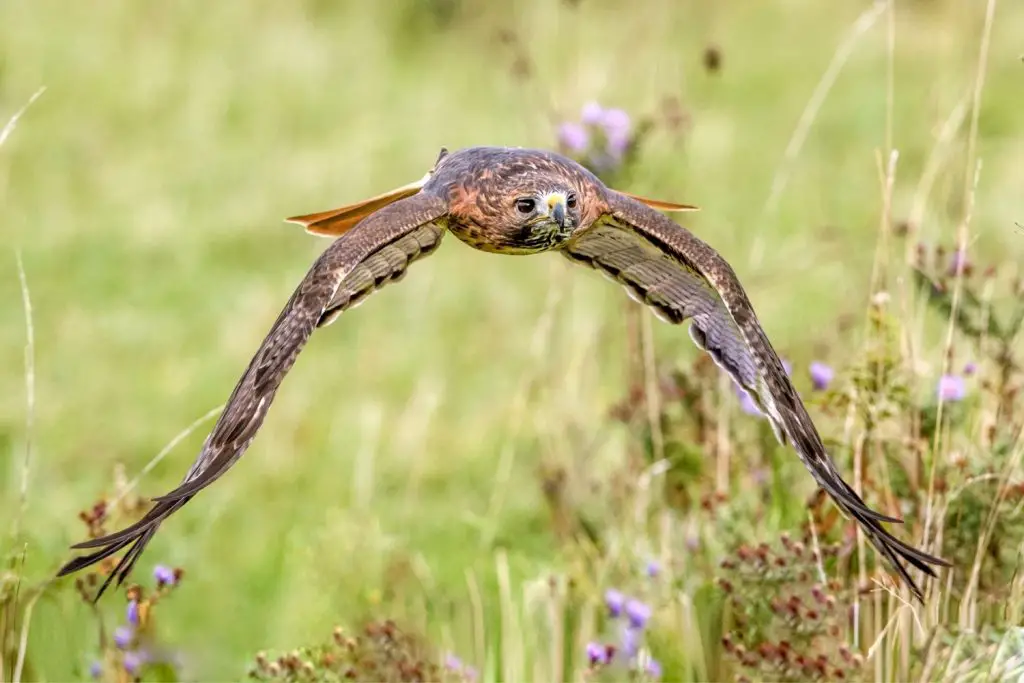
How do hawks kill chickens? A hawk will circle its prey, scoping them out, sometimes for a couple days before finding the right moment to swoop down for the kill. It will grab the chicken with its extremely sharp talons and use its hooked, razor sharp beak to dislocate its neck and eat the chicken.
Hawks use their strong legs and feet to hold down a chicken and it uses its sharp beak to pull at the chickens neck to dislocate it. Its sharp talons and strong leg and toe muscles are made to grab, hold and carry its prey.
It starts at the head, dislocating the neck, and proceeds to pull out feathers and eat the meat of the head, neck(crop) and breast.
Do hawks eat chickens? Most chickens are too large for a hawk to be able to pick up and carry away. Instead, a hawk will feast on it where it was attacked. The hawk will eat as much as it can, fly away to nearby tree and come back when it is ready to eat some more.
If it has a nest of young fledglings to feed, it will tear little chunks off and bring it to the nest to feed them.
Could a Hawk Fly Away With a Chicken?
Can a hawk pick up a chicken?
The average adult chicken weighs between 5-7 lbs. and the largest hawk weighs just over 3 lbs. Not even the largest hawk can fly away with a full grown adult chicken. But it can fly away with a bantam chicken or young pullet that isn’t fully grown.
Instead, what a hawk will do is rip apart chunks of the chicken. It will feast on it where it attacked it and also bring chunks of it off to feed its nest of fledglings.
Once the chicken is light enough to carry away, it will do so. The only evidence left would be a halo of feathers it plucked out while eating.
Can a Hawk Kill a Full Grown Chicken?
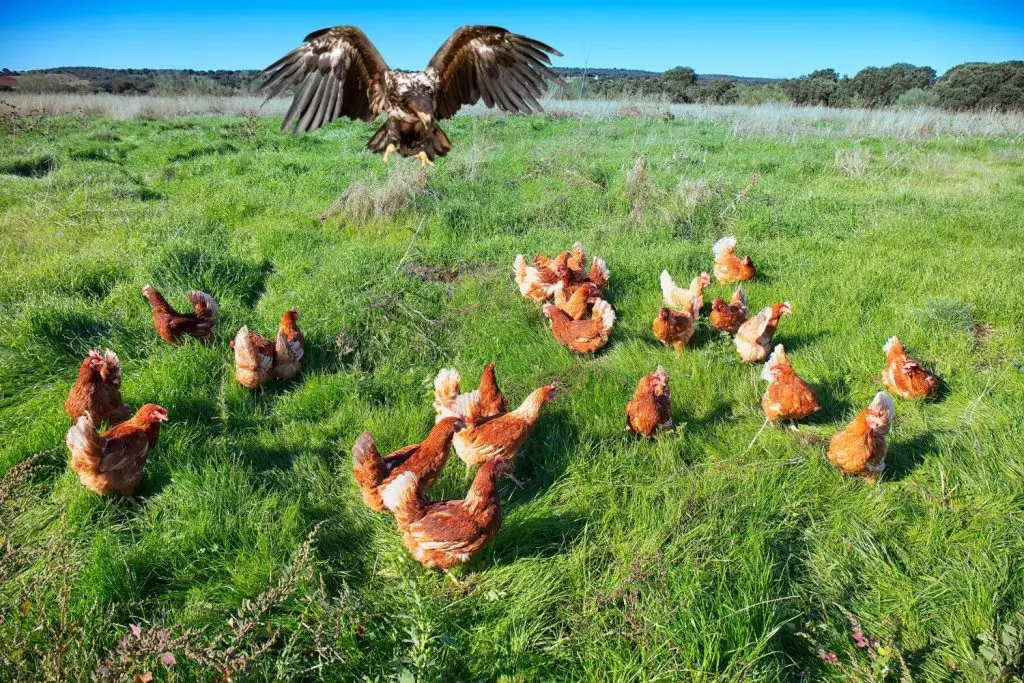
A hawk can most definitely kill a full grown chicken. It won’t do it all in one sitting, but it will take it away in chunks to feed its nest of fledglings.
Or, it will eat as much as it can in one sitting, fly away to a nearby location where it can still see its kill and return when it is ready for more.
It will do this until the chicken is light enough to carry away to a safer location.
What Time of Day Do Hawks Usually Hunt?
Hawks are diurnal birds of prey, meaning that they hunt in the daytime. This is why it is important to make sure that your free ranging flock is protected during the day.
- A hawks vision is as much as 8 times sharper than a humans.
- They can see a tiny little mouse up to 100 feet away and can dive down as fast as 120 mph to capture it.
- They do their hunting before sunset, during daylight hours.
- A hawk frequently will scope out its prey by circling from up above, sometimes for days before attacking at the right moment.
If you are lucky, you can catch a hawk before it carries your chicken away. Make sure that you have all the essential first aid supplies in case you need to clean a fresh wound from a hawks talons.
For a list of essential first aid supplies that you should have ready for your chickens in case of an emergency, read my article What Do I Need in My Chicken First Aid Kit?
What Do Hawks Eat?
Hawks eat a variety of rodents, insects, reptiles and birds. This list is some of the most common things eaten by hawks:
| WHAT DO HAWKS EAT? | |
|---|---|
| RATS | MICE |
| SQUIRRELS | VOLES |
| RABBITS | VARIOUS BIRDS (INCLUDING CHICKENS AND SONGBIRDS) |
| VARIOUS REPTILES (INCLUDING SNAKES) | FROGS |
| TOADS | INSECTS: GRASSHOPPERS, DRAGONFLIES |
| BATS | CHIPMUNKS |
| LIZARDS | CRAYFISH |
| CRABS | GOPHERS |
| PRARIE DOGS | LEMMINGS |
What Can I Do if a Hawk is Killing My Chickens? (Chicken Protection from Hawks)
If you are having a problem with hawks attacking your chickens, there are several things that you can do to help prevent them from attacking your flock.
If you are lucky, you can catch a hawk before it carries your chicken away. Make sure that you have all the essential first aid supplies in case you need to clean a fresh wound from a hawks talons.
Chicken Protection from Hawks-9 Best Ways
1. ROOSTERS
Get a rooster to protect your flock. Roosters will stand guard and alert the flock if a predator is nearby. He will not hesitate to fight off a hawk either. A rooster will protect his hens to his death.
If you are able to have a rooster where you live, it is highly suggested to get at least one rooster for every 10 hens to protect the flock.
2. HAWK NETTING
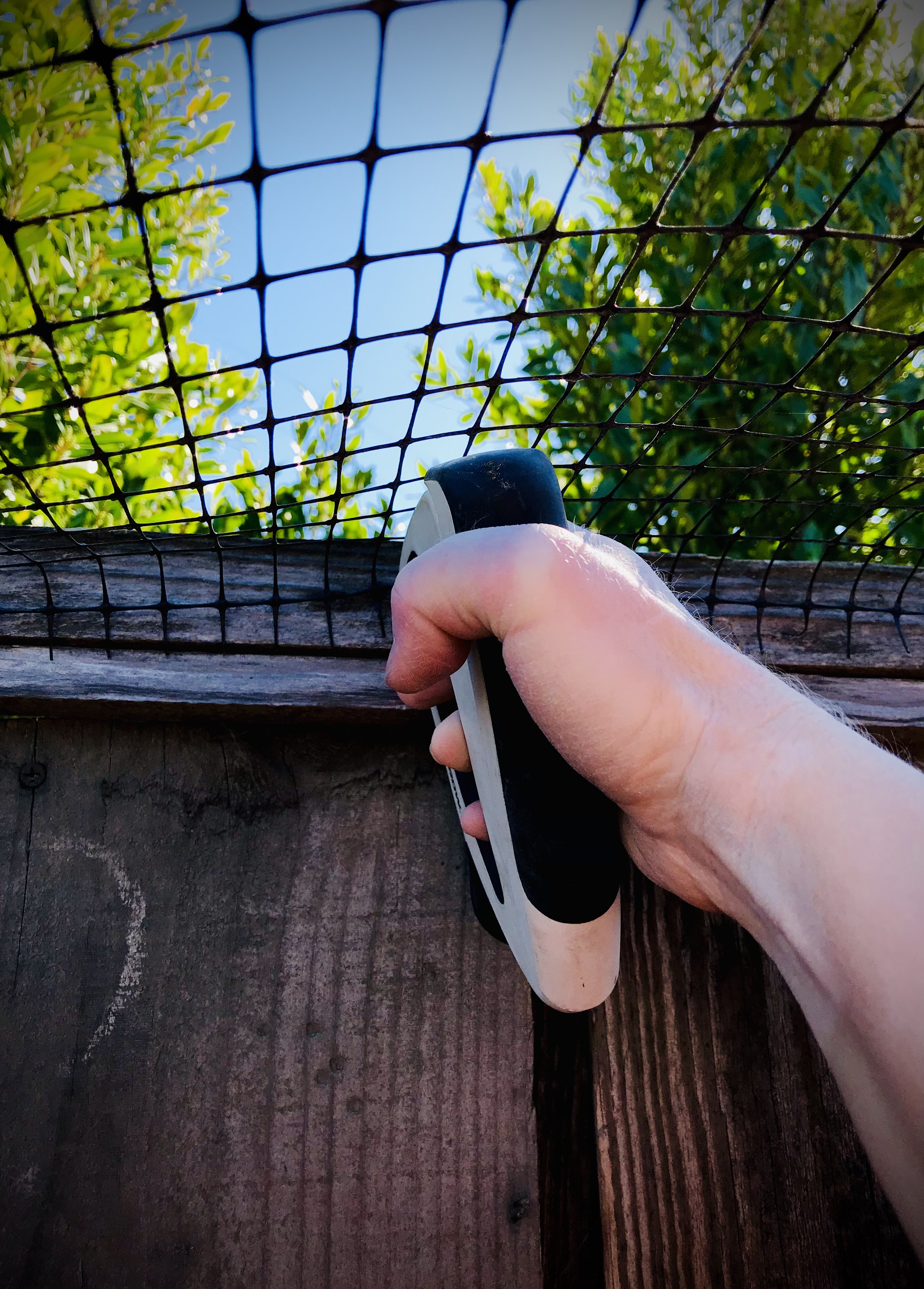
If you don’t have a very large area that your flock free ranges, consider covering it up above with some hawk netting. If is relatively inexpensive and easy to install with a manual staple gun.
3. DECOYS
Decoys such as owls and scarecrows work great if you use them properly. In order to be effective, you need to move them every few days. This way, hawks think that they are alive when they see that they changed locations.
Place decoy owls in common places, such as up in trees, on top of a building or on a high pole.
Place scarecrows out in the field where your chickens are free ranging. Remember to move them around, otherwise hawks may get used to seeing them there and not think of them as a threat.
4. GUARD DOG
If you live in an area that hawks frequent and want to allow your flock to free range, consider getting a guard dog that is bred to protect livestock. The following breeds are the top 4 dog breeds used to protect livestock:
| BREED | BENEFITS |
|---|---|
| KUVASZ (SHEEPDOG) | LIVESTOCK GUARDIAN DOG |
| GREAT PYRENEES | BRED FOR OVERSEEING LIVESTOCK |
| ANATOLIAN SHEPHERD | LIVESTOCK GUARDIAN DOG |
| OLD ENGLISH SHEEPDOG | FARM HERDING DOG |
Guard dogs will also help to protect against many other predator attacks. For more information on other predators that we need to protect chickens from and pro tips on how we can protect them, read my article:
5. NOISE
Hawks don’t like noise and prefer to stay away from it. The idea is not to have noise going on all the time and to switch out what type of noise they hear. This way, it will keep them unsure and less likely to come around.
Have a radio that turns off and on at various times of day. Switch out what type of music or talk radio plays on it.
Hang pin wheels that spin and make noise in the wind. Change out the location of these every few days.
Hang some wind chimes from various branches that will make noise when the wind blows.
6. PROVIDE ADDITIONAL COVER
If you allow your chickens to free range, make sure that they have enough areas to run for cover should a hawk swoop down for one of them.
Consider adding a small chicken tractor that chickens can run to take cover should a hawk try to attack.
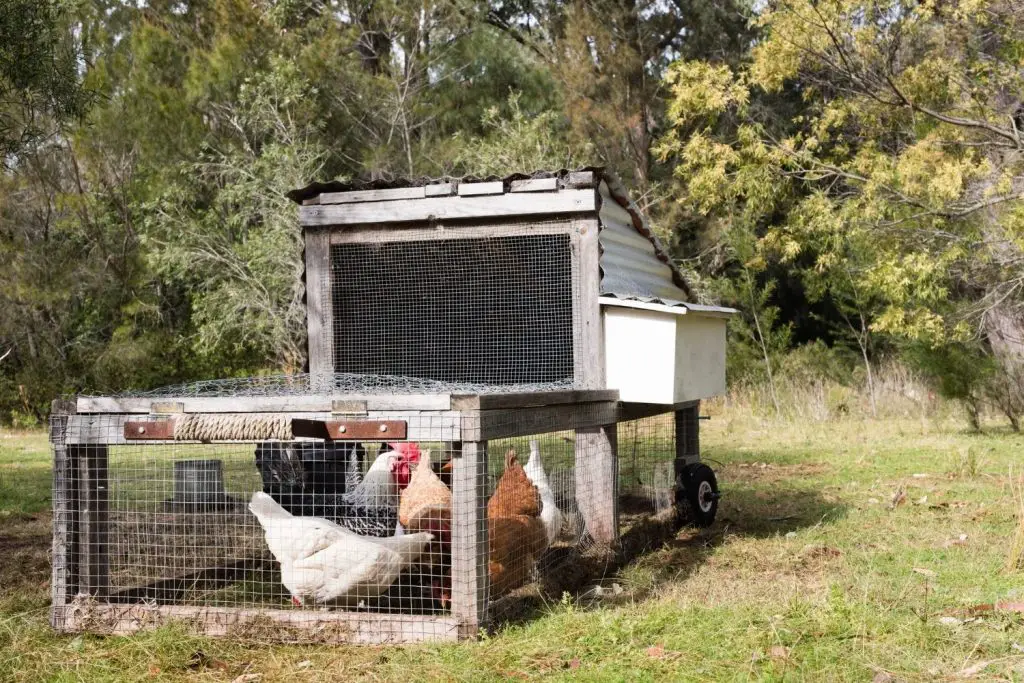
7. CHANGE FEED LOCATION
Hawks are smart and will wait until chickens are off guard, such as when they are eating, to swoop down for the attack.
Don’t have feeders out in the wide open. Instead, provide your flocks feed in an area that is protected from arial predators, either with hawk netting or a roof top.
8. HANG CD’S
Hawks don’t like things that flash. It confuses them, so they prefer to stay away. Hang several of your old CD’s from tree branches and chicken coop with fishing line to deter them.
When the sun hits the CD’s it will create bright flashes, chasing them away.
Periodically change the location of your hanging CD’s to keep the hawks wary!
9. SUPERVISED FREE RANGING
When in doubt, you can always supervise your free ranging chickens. This is especially good to do if there have been recent attacks. Once a hawk attacks it is likely to come back for more.
If you have young pullets or chicks you should always be out to supervise if you cannot provide protection from arial predators.
For more helpful tips on what you can do to protect your chickens from predators, read my article 11 Common Backyard Chicken Predators – How to Best Prevent Attacks.
Can You Shoot a Hawk if it is Attacking Your Chickens?
No, you cannot shoot a hawk if it is attacking your chickens. They are protected by the Migratory Bird Treaty Act of 1918.
This act was established in 1918 and states that it is illegal to, “pursue, hunt, take, capture, kill, attempt to take, capture or kill, possess….” birds of prey. This also includes their feathers, eggs and nests.
If you are caught violating this law it is a misdemeanor, punishable with up to a $500 fine or up to 6 months in jail.
Capturing and selling any birds of prey is punishable with up to a $2000 fine and up to 2 years in jail.
For more details on the Migratory Bird Treaty Act of 1918, visit For more details on the Migratory Bird Treaty Act of 1918, visit the laws digest of U.S. Fish and Wildlife Service.
What are Hawks Afraid of?
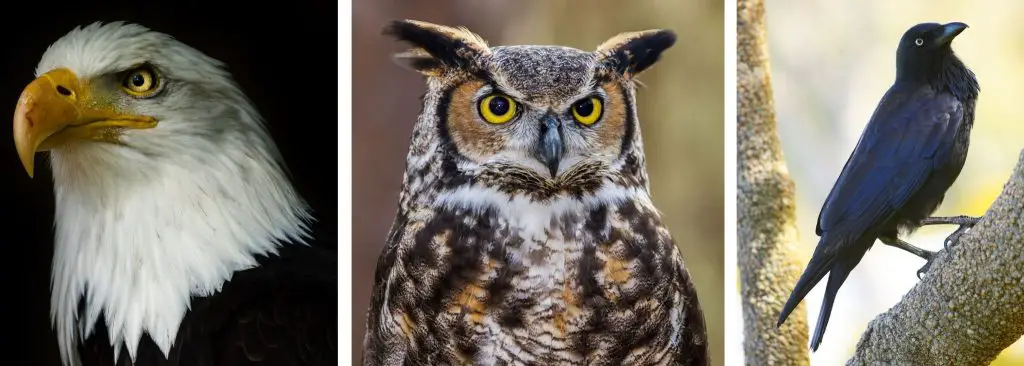
Hawks may be fierce birds of prey, but there are a few other birds that will put them in their place. Hawks are afraid of crows and owls, but their number one bird that they fear is the eagle.
EAGLES
Eagles are much more skilled at hunting and one of their favorite meals is the hawk.
OWLS
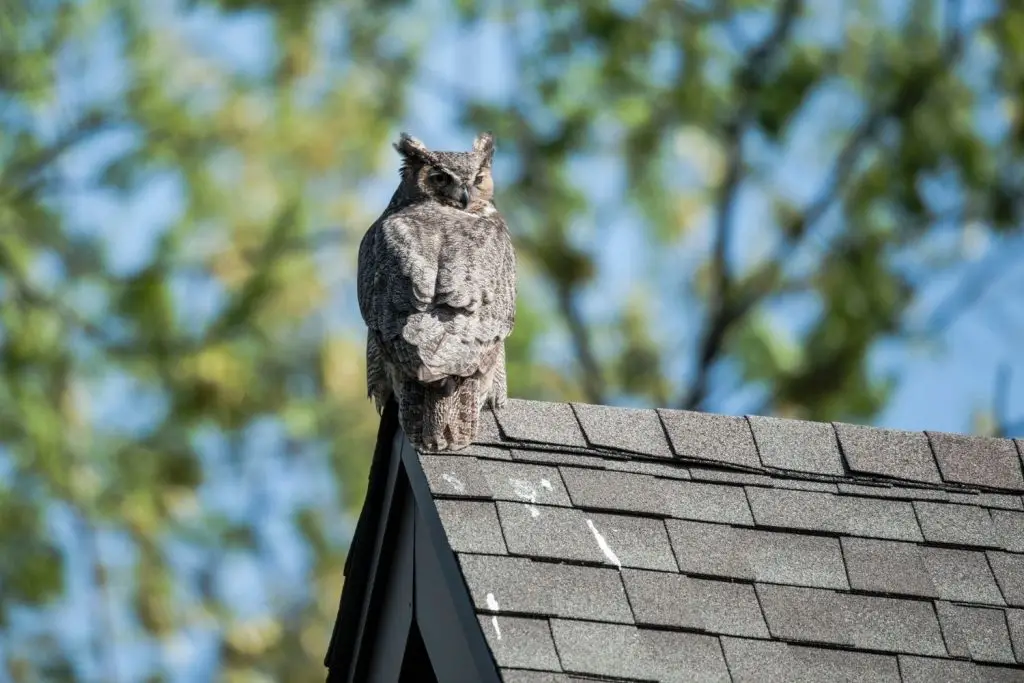
Owls have been known to catch a hawk off guard and knock them off the nest in the middle of the night. Hawks tend to try to stand clear of owls. In fact, many flock owners will use decoy owls to deter hawks.
CROWS
Unlike hawks, crows travel in “mobs” and tend to intimidate hawks not only by their numbers, but also their fierce sounds that they make.
Other animals that hawks have trouble with are snakes and raccoons. They have been known to steal hawk eggs from nests.
Will a Fake Owl Keep Hawks Away from Chickens?
Decoy owls or “fake owls” will help to keep hawks away from your chickens if it is used effectively.
In order for decoy owls to be effective, you must move the owl to different locations every couple days. This makes hawks think that they are alive and moving around.
It is best to place your decoy owl in places that real owls really will perch, such as on top of a building, in a tree or up on top of a pole.
Will a Hawk Attack a Human?
Hawks are very unlikely to attack a human unless it is a mama hawk trying to protect her eggs or fledglings. It is always best to stay away from hawk nests, especially during breeding season!
Along with fleas, ticks and lice, hawks also carry well over 60 different diseases that can be passed to humans. These are some of the most common diseases that can be picked up from either touching a hawk or their droppings.
| COMMON DISEASES PASSED FROM HAWK TO HUMAN |
|---|
| E.COLI |
| WEST NILE VIRUS |
| CANDIDIASIS |
| AVIAN INFLUENZA |
| AVIAN TUBERCULOSIS |
| ERYSIPELOID |
| PASTEURELLOSIS |
Chicken Predators Chart
| PREDATOR | % BACKYARD CHICKEN OWNERS REPORTED ATTACKS (2,660 VOTES) |
|---|---|
| RACCOON | 25.3% |
| HAWKS, OWLS, EAGLES | 19.4% |
| DOG | 15% |
| FOX | 11.7% |
| COYOTE | 5.1% |
| WEASEL | 4.7% |
| MAN | 3.7% |
| MINK | 2.5% |
| OPPOSUM | 2.3% |
| BOBCAT | 2% |
| CAT | 1.9% |
| RAT | 1.9% |
| BEAR | 1.7% |
| SNAKE | 1.2% |
| SKUNK | 0.9% |
| MOUNTAIN LION | 0.6% |
List of Largest Hawks
HAWK | WEIGHT |
|---|---|
| RED-TAILED HAWK | 2.4 lbs. |
| OSPREY | 3.0 lbs. |
| COOPERS HAWK | 1.2 lbs. |
| COMMON BUZZARD | UP TO 3 lbs. |
| NORTHERN GOSHARK | 1.5-3 lbs. |
| BLACK KITE | 1.5 lbs. |
| RED SHOULDERED HAWK | 1.3 lbs. |
| ROUGH LEGGED BUZZARD | 2.3 lbs. |
| COMMON BLACK HAWK | 1.8 lbs. |
| FERRUGINOUS HAWK | 3.3 lbs. |
| WESTERN MARSH HARRIER | 1.6 lbs. |
| BLACK SPARROW- HAWK | UP TO 2.2lbs. |
Conclusion: How do I know if a Hawk Attacked My Chickens?
One of the top predators of chickens is the hawk.
When it comes to protecting chickens, the first thing we often think of is making sure that the chicken coop and fencing is secure.
Equally important is protecting your chickens from arial predators, such as the hawk.
Whether you live in a rural area or in the city, it is important to take whatever precautions you can to prevent your flock from being attacked by arial predators such as the hawk.

